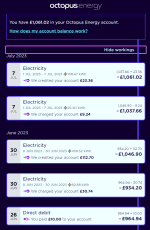@Mercenary Keyboard Warrior perhaps see if you can get them to swap out battery 4.
When I first installed my second battery, both battery BMSs reported very similar SOC as the Victron system, but I've noticed one battery drifted quite a way out, and has now drifted more back in line. In mine it's the Victron shunt which sets the SOC that the system runs by, and voltage plays a part as well. The BMSs jist act as safe gaurds for each battery, and balance individual cells in that battery.
We were going to then decided not to. New battery was sitting in front of inverter ready to go.
Thing is even if batt 4 fell into line with the others, the input from grid would be about 10.2kwh and battery storage would have gained 9.5kwh(ish)
Its supposed to be 11 useable so well short of that. It needs to draw circa 11.5-6 kwh to get the 11 usable, or maybe more depending on efficiency.
If it seemed much closer then batt 4 might be good enough but its still well out from specs even if that matches the others.
Bear in mind those numbers above were charged individually. So 1-3 are probably 3-400w or so down on input needed, and 250w or so for battery charge added.
Batt 4 is a bit higher again.
It looks to me like something significantly out.
Can you not get hold of a 10A charger and finish from say 90% charge each battery to 100% individually, then when you sure all are 100% do your discharge tests. With 4 all connected the bms may halt charging or reduce the current right down on all when they are not equal.
These were charge tests as we can identify the numbers quite specifically. The discharge is harder since load varies on the house.
But I guess we could force discharge as well.
Main issue is time, I am towards the edge of the installers patch. So each discussion then ends up in 2-3 weeks before they can be in the area again.
If the manufacturer gets involved add another 1-2 weeks and potentially a daft answer.
The batteries need to be charged via the manufacturer BMS I think.
The overall picture was very much individually like when all are together.
It charges and stops faster than it can mathematically do so to complete what it should. And the graphs are kind of steady from 10%(ish) upto around 80% then jump to basically 100% in the next 5 minutes.
At this same point in time the current is dropping. Annoyingly you watch the data in real time connected via wifi to teh inverter but web logging is 5 min averages.
Its close but the web data is not necessarily perfect. It roughly lines up with Octopus for example when I charge early hours of the morning but the disagree by 2% or so.



